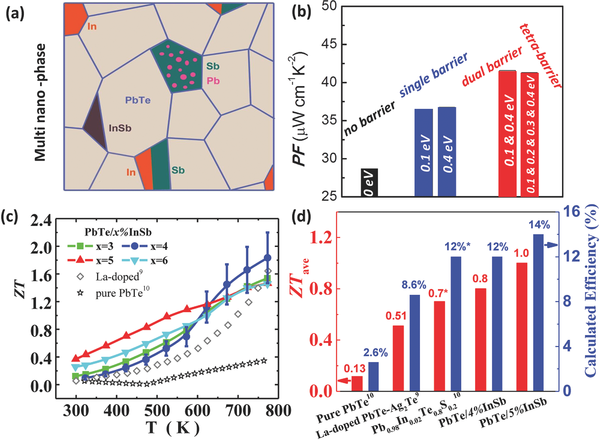Researchers make breakthrough in magnetic geometry-induced quantum geometry and nonlinear transport
2025-06-06SUSTech hosts IOP Forum with President of Institute of Physics Sir Keith Burnett
2025-03-26Researchers discover unusual thermal conductivity in high-symmetry single crystals
2025-03-26New efficient method detects quantum temporal correlations
2025-03-26Researchers explore unconventional magnons predicted by spin space groups
2025-03-25Recently, Professor Jiaqing He’s research group, from the Department of Physics, published their recent research results on two different top journals in the material and energy fields, respectively. The first paper, entitled “Extraordinary Thermoelectric Performance Realized in n-type PbTe through Multiphase Nanostructure Engineering”, is published on the Advanced Materials, where Dr. Jian Zhang and Dr. Di Wu are the co-first authors, with Professor Jiaqing He as the corresponding author. The second paper, entitled “Large Enhancement of Thermoelectric Properties in n-type PbTe via dual-site point defects”, is published on the Energy & Environmental Science, in which Dr. Liangwei Fu and Dr. Meijie Yin are the co-first authors, and Professor Jiaqing He and Assistant Professor Li Huang are the co-corresponding authors.
Thermoelectrics are deemed as promising for clean and sustainable power generation from waste heat at various temperature grades. Practical application of thermoelectric devices requires both -type and n-type thermoelectric materials with comparable properties. Lead telluride has long been realized as an ideal p-type thermoelectric material at an intermediate temperature range. Prof. He’s research group has been focus on the PbTe materials and thermoelectric devices. Previously, Prof. He’s group reports that p-type PbTe shows very high peak figure of merit, ZTmax = 2.3@923K (Energy Environ. Sci., 2015, 8, 2056), and very high average figure of merit, ZTave=1.56 (Nat. Commun. 2014, 5, 4515) in a wide temperature range, which is corresponding to a theoretical energy conversion efficiency of 20.7%. However, the relatively inferior performance of n-type legs impedes the application of PbTe materials in intermediate temperature thermoelectric devices. Now this major limitation is largely solved here.
In the first paper, significant enhancement in thermoelectric performance is attributed to the incorporation of InSb into the PbTe matrix resulting in multiphase nanostructures that can simultaneously modulate the electrical and thermal transport. On one hand, the multiphase energy barriers between nanophases and matrix can boost the power factor in the entire temperature range via significant enhancement of the Seebeck coefficient and moderately reducing the carrier mobility. On the other hand, the strengthened interface scattering at the intensive phase boundaries yields an extremely low lattice thermal conductivity. As a result, a record-high ZT value of ≈1.83 can be achieved at 773 K in n-type PbTe-4%InSb composites.

FIG 1: a) A schematic illustration showing the existence of multi-nanophases in the PbTe matrix. b) A comparison of energy filtering effect on the thermoelectric power factors in n-type PbTe between multicarrier and single barrier at 300 K, based on single parabolic band model simulation. c) Temperature-dependent ZT values of PbTe-x% InSb composites with x = 3, 4, 5, and 6, respectively, along with results from the literature. d) Corresponding average ZT values ZTave and calculated efficiency η at the temperature gradient of 300–723 K.
In the second paper, some Sb phases was added into 0.1% PbI2-doped PbTe by a conventional melting method. Transmission electron microscopy (TEM) analysis together with density function theory (DFT) calculations showed that endotaxial Sb nanoprecipitates were produced in the PbTe samples at room temperature, and that part of these nanoprecipitates gradually dissolved into the PbTe matrix to form SbPb–SbTe dual-site substitutional point defects as temperature increased. Substitution of Sb for two closest Pb and Te sites at high temperature empowers formation of duel-site point defects, which contribute to distortion of the electronic density-of-states and additional phonon scattering. A maximum ZT of about 1.8 was achieved at 773 K for the n-type PbTe0.998I0.002–3% Sb composite, which together with the result in the first paper is the record high value among n-type PbTe materials at present.

FIG 2: (a) The evolution of Sb nano in PbTe matrix. Under low temperature, Sb nano precipitation appears in the PbTe matrix while in high temperature part of the nano Sb part dissolves into PbTe lattice to form the "dual-site" point defect. (b) Temperature-dependent ZT values of our sample and some of the best n-type PbQ (Q=Te, Se, S) materials in literatures. The peak figure of merit value (ZTmax) of our sample is better.
This series of recent achievement in n-type PbTe thermoelectric materials reinforced the application prospect of PbTe in mid-temperature for both thermoelectric power generating and cooling. The research has been supported by the National Natural Science Foundation of China, Natural Science Foundation of Guangdong Province China and the Shenzhen Commission on Innovation and Technology.
Source Link:
http://onlinelibrary.wiley.com/doi/10.1002/adma.201703148/full
http://pubs.rsc.org/en/content/articlelanding/2017/ee/c7ee01871a